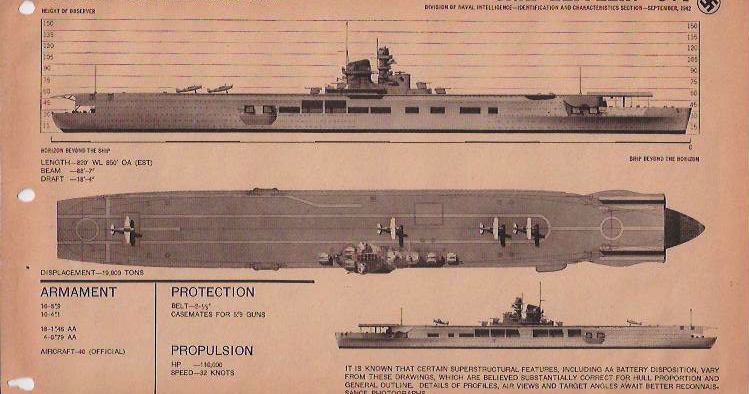Let's see. The earliest KM Graf Zeppelin could be finished is late 1940. Then she will sit in port while her Luftwaffe air group works up on land bases for the most part, with perhaps a few live exercises in the sheltered Baltic to practice their carrier landings and use of the catapults. Then the order to accompany KM Bismarck and KM Prinz Eugen on their Atlantic breakout comes.
Everyone is in high spirits as the three ships leave Kiel and head to Norway, where their location is revealed to the British. Because the German surface raiders are accompanied by an aircraft carrier, the British response ensures that an Illustrious-class carrier accompanies HMS Prince of Wales, HMS Hood, and several crusiers hopping to intercept the Germans in the Denmark Straits.
On board Graf Zeppelin, the Luftwaffe aircrews find that operating their jury-rigged Bf-109T's and Ju-87C's from the rolling and pitching carrier deck is far different from their training in the calm Baltic. After three landing accidents destroying a Ju-87 and two Bf-109s, the Kriegsmarine orders the Luftwaffe air group to cease any further flights until any enemy ships are sighted. This timidity disgusts the several Japanese naval advisors on board the carrier, who have little doubt their own flight crews would have little difficulty conducting flight operations in similar conditions. They also know the British (whom the IJN still admires) will be in the air.
As the Japanese advisors suspected, the Royal Navy knows its stuff. A Martlet from HMS Illustrious make an initial contact with the German raiders north of Iceland, and this is followed by an attack by 14 Swordfish torpedo bombers. Graf Zeppelin is the focus of the attack, in which she is struck by one torpedo that starts a fire, crippling the aft elevator.
The Germans are then saved by increasing fog that forces the British to suspend air operations. However, unknown to the British a battle of sorts is brewing on the Graf Zeppelin, between the ships's Kriegsmarine commander and the Luftwaffe general commanding the air unit. Finally Lutjens on Bismarck is forced to intervene. Incensed that the British seem to have little difficulty operating their carrier aircraft, Lutjens orders the Luftwaffe to throw caution to the wind and ensure that a CAP is up at all times and Ju-87 dive bombers are fueled and armed on deck to immediate launching as soon as any British ships are encountered.
The Luftwaffe aircrew gets it's chance to redeem itself when the visibility improves and Prinz Eugen sights HMS Sheffield, which had been trailing the Germans at a discreet distance until both ships made course corrections that inadvertantly brought them into range of each other. The order is given to launch a strike at Shellfield with all 14 Ju-87s on deck. What transpires is a deadly comedy of errors. First, it takes far too long for the catapult system on Graf Zeppelin to launch all the Stukas, and by the time the small flight has reached an appropriate altitude to underake dive bombing attacks, Sheffield is no longer in visual range of Prinz Eugen. However, the Luftwaffe is determined to show up those Navy bastards. Flying to Sheffield's last reported position, they sight a cruiser and attack it. Unfortunately, the cruiser is Prinz Eugen, whose KM coded messages to the Stukas are ignored because the flight crews only have Luftwaffe code books with them. Luckily for the German cruiser, the Stukas fail to damage their target, but they then must manage a sucessful landing back on the Graf Zeppelin. Four of the Fourteen aircraft crash on landing, one plowing into the island bridge.
While Graf Zeppelin is attempting to recover her aircraft she separates from the Bismarck and fog again returns. As the ships separate, Graf Zeppelin steams directly toward the Sheffield, whose commander is astonished to see an aircraft carrier emerge from the fog in point blank range for his 8-inch guns. What develops is a running battle between the two ships, with Sheffield landing numerious hits but also taking severe damage herself from the Graf Zeppelin's strong gun battery (the Kriegsmarine my be incompetent with aircraft, but its gunnery is always excellent). In fact, the carrier's gunnery is so effective that Sheffield is forced to retire from the action
By now the commotion has brought Lutjen's into the fray and also attracted the attention of Illustrious, Hood and Prince of Wales. Illustrious's swordfish begin the action with a sucessful strike at Graf Zeppelin, leaving her listing and taking on water. Unaware that the British capital ships are closing on his position, Lutjen's orders Prinz Eugen to take off survivors and scuttle the carrier. While this operation is underway and Bismarck is slowly idling about, a nearly stationary target herself, Hood and Prince of Wales emerge from the gloom. The rest is of course, history. But to this day the Battle of the Denmark Strait is remembered as the greatest British naval victory since the days of Nelson - three major German naval units sunk with only minor damage to Sheffield
